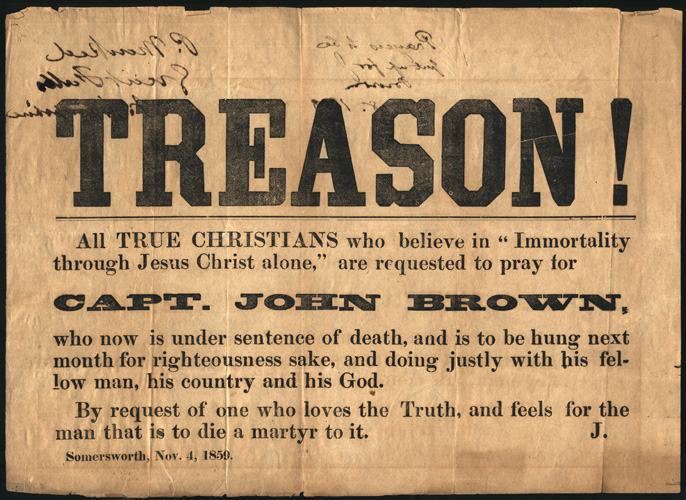By: MOLLY WICKER
John Brown left an indelible mark on American history. On the night of October 16, 1859, Brown and a small band of followers lead an armed assault against the U.S. military arsenal at Harpers Ferry. The raid was intended to be the first stage in an elaborate plan to establish an independent stronghold of freed slaves in the mountains of Maryland and Virginia. Brown was captured during the raid and later convicted of treason. Although the raid did not achieve its ultimate objective, it nevertheless inflamed slave owners’ fears of slave rebellions and increased the mounting tension between Northern and Southern states before the American Civil War.

Getty Images
Brown was born on May 9, 1800 in Torrington, Connecticut, in a Calvinist household. John Brown came from a staunchly anti-slavery family. As a young boy traveling through Michigan, Brown saw firsthand the effects of slavery on those who were enslaved. He initially believed that ministry would be the best way to dismantle slavery, but instead decided to become a tanner, like his father. He married Dianthe Lusk in 1820 and the couple had several children before her death in the early 1830s. He remarried in 1833 and he and his wife Mary Ann Day also had many children.
For much of his young adult life, Brown was an ardent abolitionist who worked with the Underground Railroad and the League of Gileadites. In 1837, his life changed when he attended an abolition meeting in Cleveland, during which he publicly announced his dedication to destroying the institution of slavery.
In the 1850s, Brown traveled to Kansas with five of his sons to fight against the pro-slavery forces in an on-going contest to win the territory. After pro-slavery men raided the abolitionist town of Lawrence on May 21, Brown decided to seek revenge. By 1857, Brown returned to the East Coast to begin to raise money in order to carry out his abolitionist vision. His group grew slowly, eventually evolving to include more than twenty men, all from different backgrounds.

The 22nd New York Infantry near Harpers Ferry in what was then Virginia, circa 1860-1865. Courtesy of the national archives.
On the night of October 16, 1859, Brown and followers overtook the federal arsenal. His men took several hostages, including some slaves. News of the raid spread quickly and by the following day, less than 36 hours later, Brown and his men were surrounded. On October 18, a group of U.S. Marines, led by Colonel Robert E. Lee and Lieutenant J.E.B. Stuart entered the compound and attempted to take control of the situation. Brown was wounded in the process of being captured. Ten members of his militia were killed, including two of Brown’s sons. Brown was tried by the state of Virginia for treason and murder and found guilty on November 2, 1859.

Library of Virginia public guides, civil war section
At the time, the raid signaled the most daring instance of rebellion against the American institution of slavery. Brown himself became a prominent figure in American history, idolized by some and loathed by others.
Well into the 20th century, it was common for some to dismiss Brown as an irrational fanatic. Although the raid hastened the arrival of the civil war, it also important to note that many issues surrounding race, justice, and freedom require a nuanced view. The raid was unsuccessful, but it represented something larger. For one of the first times in history, the majority of the participants were northern abolitionists, signaling the start of a national division on the issue of slavery. The abolitionists not only risked their lives for their own personal convictions, but also for the lives of others, offering the first glimmer of hope for thousands of Americans.
“Brown was thought mad because he crossed the line of permissible dissent,” says historian John Stauffer, author of The Black Hearts of Men: Radical Abolitionists and the Transformation of Race. “He was willing to sacrifice his life for the cause of blacks, and for this, in a culture that was simply marinated in racism, he was called mad.”




